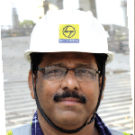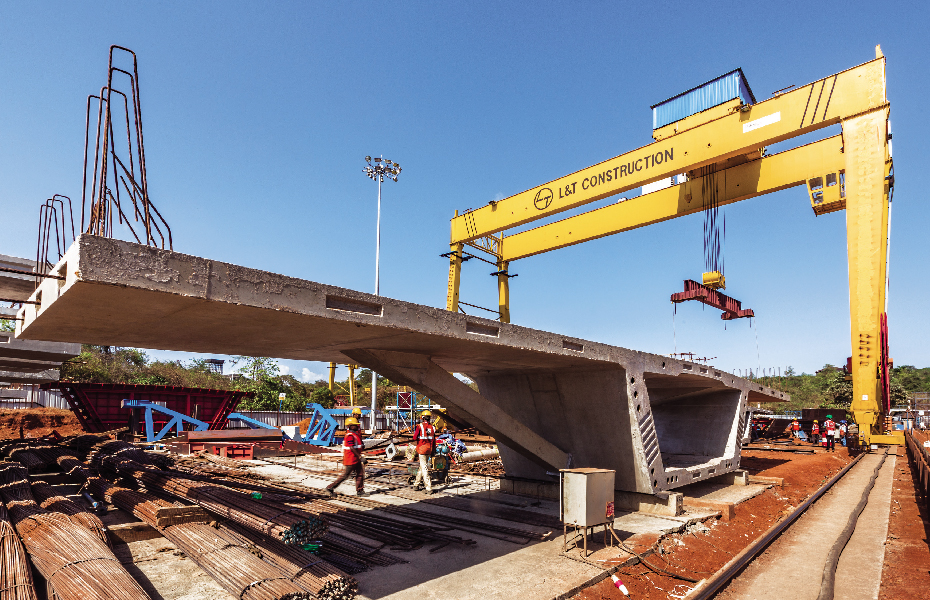PRECASTING IS EASY; LIFTING PRECAST ELEMENTS NOT SO!
Understanding the hazards and safety measures to lift heavy precast elements
Several engineeringly challenging structures are taking shape with speed and precision thanks to the advantages of precast engineering. Be it the Motera Stadium, soon-to-be the world’s largest cricket stadium, or the Al Rayyan stadium in Qatar being made ready for the FIFA 2022 Football World Cup or a series of metro rail systems, high-rise residential towers or factories, L&T has certainly taken precasting to the next level.

Advantage precast
“We had all of 43 columns each 30 m in height, 2.7 m width and weighing 285 tonnes to erect,” shares Project Director, Subrata Dutta (SD), of the Motera Stadium project. “Casting them insitu would have taken us at least 2 months per column but by precasting the columns we were able to complete each column in a cycle time of about 10- 12 days with the required strength.”
Economical, quicker to produce, requiring less skilled labour, precasting is truly rewriting the rules of the game. “Most importantly, since precast elements are manufactured in a controlled casting environment, it is easier to control the mix, placement and curing and get exactly what the design prescribed to the quality we seek,” explains the CMPC In-charge of the Motera project, Maulik Shah. What’s more, precast elements can be standardized, repeated, eliminates waiting time for erection at site, takes weather out of the equation because in a factory, elements can be cast in rain or shine and curing can even be accelerated by heating certain parts.
The project team at Lucknow Metro can thump their chests for constructing some of the fastest built metro systems in the country thanks to precast girders and structures. Project Director, Sanjay Singh Gangwar fondly recalls planning the alignment at one of the busiest sections in the heart of Lucknow “where even finding parking space for a jeep was an issue!” The original plan of insitu viaduct slabs was shelved in favour of “7 precast, curved ‘U’ girder spans, first-of-their-kind in India, aligned to a 90 degree curve along a minimum radius of 120 m as per Indian Railway standards that saved us a lot of time earned the good will of the people as not a single public property was disturbed.” Precasting gave the team flexibility too for where the conventional ‘U’ girder format was difficult to execute, they could quickly switch over to steel ‘I’ or box girders to proceed with execution.

Hazards of lifting precast elements
Lifting these huge precast girders or columns or any other big structure come with several attendant risks. Overloading of cranes, gantry cranes failing during tandem lifting of loads or when shifting the heavy load, loads getting shifted with the gantry, failure of the lifting accessories or even a collision of either the lifting equipment or the loads are some common hazards that lifting and EHS managers have to deal with. Over and above all these, is the crucial consideration of human intervention. “A careless crane operator or inattentive workman can spell danger for all,” cautions G. Divakar, Senior Manager EHS, HCI “hence, it is extremely critical to have a proper lifting plan in place, that is clearly communicated to all involved and the workmen need to be specially trained if the lift is a complicated one.”

A careless crane operator or inattentive workman can spell danger for all, hence, it is extremely critical to have a proper lifting plan in place, that is clearly communicated to all involved and the workmen need to be specially trained if the lift is a complicated one.
G Divakar
Senior Manager EHS, HCI IC
Ensuring safe lifting of precast elements
Plan a lift
An hour of planning can save one hours of doing. Like in any activity at site, a lift should also be carefully planned considering all loads involved, site conditions, risks both seen and unseen and the ‘Executive Supervisor’ (ES) should prepare a complete Lift Method Statement that becomes the ready reckoner for all lifts.

Certainly, no lift should even be planned without knowing the exact weight of the load and it is important to consider aspects like weight of the lifting gears, spreader pieces, crane hook and fall ropes when calculating the total weight to be lifted.
Santhosh Bore
EHS In-charge, Motera
“Ideally, it is advisable to perform a trial lift on empty condition to check the conditions like load capacity, obstructions and the like, after verifying the dimensions with the design drawings,” cautions Santosh Bore, EHS In Charge at the Motera site after his experience of performing several complicated lifts in fairly confined spaces. “Certainly, no lift should even be planned without knowing the exact weight of the load and it is important to consider aspects like weight of the lifting gears, spreader pieces, crane hook and fall ropes when calculating the total weight to be lifted.”
The lift plan determines and incorporates the position of the crane starting from unloading the load from trailer to the ground, moving it closer to the erection spot, final position of the crane for lifting and the sequential operation of multiple cranes. Lifting a load out of water should not be attempted without considering the buoyancy load.

Prepare for a lift
Like a pilot’s series of pre-checks before take-off, the ES has his own. The area of lifting should be cordoned off with only specially trained personnel involved with the activity present. Care must be taken to ensure that the lifting device is not loaded in excess of its rated load or made to handle a load for which it is not designed. It is the operator’s responsibility to ensure that the field is clear of all obstructions, the ropes or chains are not kinked, the multiple part lines are not twisted, the load is evenly distributed and not swinging before giving the green signal for the lift to proceed.

Choice of cranes
Armed with a sound lifting plan, the next step is to choose the right kind of cranes. Manager EHS, Gabrial Fernandez shares, “Cranes with the same configuration are best suited for tandem lifts but in case they are unavailable, then those with similar configurations in terms of type, make, winch speed and breaking efficiency need to be mapped before making the choice and it is prudent to de-rate the crane capacity by 25% in case of a tandem lift.”

Cranes with the same configuration are best suit for tandem lifts but in case they are unavailable, then those with similar configurations in terms of type, make, winch speed and breaking efficiency need to be mapped before making the choice and it is prudent to de-rate the crane capacity by 25% in case of a tandem lift.
Gabrial Fernandez
Manager EHS
Crane operations
Gantry cranes engaged in tandem lifts should be synchronized, operated with a single remote and inter-locked for safe material handling. Until the inter-locking they are controlled administratively through inspection checks. Gantry cranes should ideally be moved at minimum speed, maintaining a gap with the load and ensuring centre of gravity. The slings should be of suitable capacity and it is important to ascertain the verticality and tightness of the lifting bars and ensure that the lifting inserts are in their correct positions. “To avoid mishaps, precast elements should be lifted about 100- 500 mm from the pedestal or casting bed to check for any issues before proceeding with the lift,” says Razi Ahmed Farooqi, the EHS In-charge at the Lucknow Metro project and a veteran of many lifts. “Rectifications are possible at this stage.” The lifting should be smooth affairs without jerks that could have dangerous shock loads acting on the crane and ASLIs installed on the cranes should automatically cut off movement if overloaded. It is also nice to be prepared with anti-collision precautions.

To avoid mishaps, precast elements should be lifted about 100–500 mm from the pedestal or casting bed to check for any issues before proceeding with the lift. Rectifications are possible at this stage.
Razi Ahmed Farooqi
EHS In-charge, Lucknow Metro projec

Human intervention
“The human factor is the most critical part of any lifting operation,” stresses Stephen Phillip Storey, Head – EHS, Heavy Civil. “The crane operator is the key to the entire operation. He must be on the ball, alert to the slightest sign of trouble to stop the lift or take corrective action. He can make or break a lift so if he shows the smallest sign of being unwell or unfit, he should be replaced immediately, or the lift postponed.” It is imperative for the operative to be well-positioned with a clear view of the operation and is in constant contact with the riggers and signallers, who are pre-designated and thoroughly briefed. “We cannot afford any miscommunication,” reiterates a serious Razi. A non-routine procedure should be followed in the event of a blind lift where the operation is out of the operator’s view.
The crane operator is the key to the entire operation. He must be on the ball, alert to the slightest sign of trouble to stop the lift or take corrective action. He can make or break a lift so if he shows the smallest sign of being unwell or unfit, he should be replaced immediately or the lift postponed.
Stephen Phillip Storey
Head – EHS, HCI IC
The ES must play the role of a conductor of an orchestra. The operator must consult with him when in doubt and respond only to his instructions and instantaneously “The only deviation is to stop an operation irrespective of whoever gives that command,” adds Stephen. The operator should clear the lift to proceed after checking all aspects and his familiarity with standard hand signals is critical. It remains his responsibility to complete the lifting operation till the load is placed, should never allow anyone else to ride with him in his cabin during the operation and keep all personnel out of harm’s way.

Safety is very much in our hands and as with any other risky activity at a construction site, lifting heavy loads is dangerous but with adequate planning, attention to detail, strong focus, coordinated effort and clear leadership, it can be achieved without incident as the Motera and many other project teams have repeatedly proved.